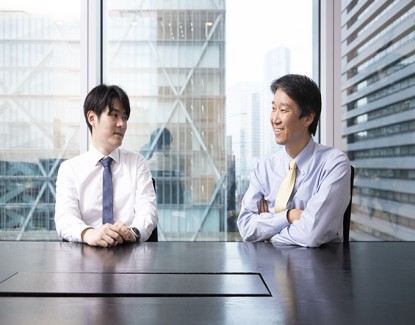Market Commentary and Fund Performance
The Portfolio Managers of Tokyo-based SPARX Asset Management Co., Ltd., sub-advisor to the Hennessy Japan Fund, share their insights on the Japanese market and Fund performance.
-
 Masakazu Takeda, CFA, CMAPortfolio Manager
Masakazu Takeda, CFA, CMAPortfolio Manager
Performance data quoted represents past performance; past performance does not guarantee future results. The investment return and principal value of an investment will fluctuate so that an investor’s shares, when redeemed, may be worth more or less than their original cost. Current performance of the fund may be lower or higher than the performance quoted. Performance data current to the most recent month end, and standardized performance can be obtained by viewing the fact sheet or by clicking here.
Market Highlights
In August 2025, the TOPIX rose by 7.13% month over month. In the first half of the month, U.S. non-farm payroll data came in below market expectations, highlighting signs of a softening labor market. This triggered a sharp drop in U.S. equities, which spilled over into the Japanese market, with the Nikkei briefly falling below the 40,000 mark. However, the weak employment data fueled expectations of U.S. interest rate cuts, prompting a global equity rebound.
Domestically, strong corporate earnings reaffirmed the resilience of Japan’s corporate sector, providing further support to the market. Mid-month, investor sentiment improved after U.S. President Trump announced a 90-day extension of certain reciprocal tariffs with China, which contributed to a continued rally and pushed the Nikkei to successive all-time highs.
Later in the month, market sentiment turned more cautious ahead of the Jackson Hole Economic Policy Symposium, and profit-taking contributed to a corrective phase. At the Symposium, remarks by Federal Reserve Board (FRB) Chair Jerome Powell further reinforced expectations of a rate cut in September. Furthermore, despite some concerns about its China-related exports, NVIDIA delivered solid earnings, supporting overall investor sentiment.
As a result, U.S. stocks remained firm, and the Japanese stock market also showed resilience, ending the month with significant gains over the previous month.
The Fund’s Performance
This month, the Fund returned 5.50% (HJPIX), underperforming its benchmark, the Russell/Nomura Total Market™ Index, which returned 6.16%.
The month's positive performer among the Global Industry Classification Standard (GICS) sectors included shares of Financials, Communication Services, and Consumer Discretionary while Information Technology, Industrials, and Health Care detracted from the Fund’s performance.
Among the best performers were our investments in SoftBank Group Corp., the telecom and Internet conglomerate, ORIX Corporation, Japan’s largest non-bank comprehensive financial services company, and Sony Group Corporation, a diversified consumer and professional electronics, gaming, entertainment and financial services conglomerate.
As for the laggards, Hitachi, Ltd., one of Japan’s oldest electric equipment & heavy industrial machinery manufacturers and Tokyo Electron Limited, one of the world's largest manufacturer of semiconductor production equipment.
August Commentary
SoftBank Group
Investment rationale since 2015
This month, shares of SoftBank Group soared to become one of the largest holdings in the Fund.
We first added SoftBank Group shares to the portfolio in August 2015. Softbank Group is not to be confused with SoftBank Corp., which is the listed telco subsidiary. Although we fully exited the Softbank Group position in 2023,1 we re-entered in the summer of last year with a small allocation, intermittently increased it thereafter, and sharply expanded the position during the second quarter of this year. Subsequently, we benefited from a rally in its share price shortly after.
Our investment thesis has been largely unchanged since 2015. Specifically:
1. High conviction in the founder/chairman, Masayoshi Son, arguably one of Japan’s most ambitious and exceptional entrepreneurs.
2. A substantial discount of the company’s share price to its net asset value (NAV), consisting of various investment assets (at the time of our purchase).
Today, as a strategic investment holding company with the mission “Happiness for everyone through the Information Revolution,” the group is focused on investments tied to AI (artificial intelligence)/ASI (Artificial Super Intelligence).
In January this year, the emergence of China based AI model, DeepSeek, sparked concerns about overinvestment in global AI infrastructure. However, it became clear a few months later that we were still in the early stages of AI infrastructure build-out. There has been no meaningful slowdown in AI related capital spending by major U.S. tech platforms.
AI use cases extend far beyond text or image generation. The development, training and diffusion of humanoid robotics (“physical AI”) and work on problems still unsolved by humanity, such as cures for intractable diseases, will require substantial advancements of AI and hence incremental investments. That implies vast demand for graphics processing units (GPUs) and, by extension, AI data centers—a view widely shared among researchers in academia.
Against this backdrop, SoftBank Group’s portfolio is anchored by ARM, a key holding. Building out AI infrastructure necessitates enormous compute. ARM provides essential low-power semiconductor architectures to run these workloads efficiently and is poised to be a critical player as AI edge devices for inference proliferate.
At present, ARM is expanding engineering headcount by roughly 1,000 per year to accelerate development of next-generation CPUs and its Compute Subsystem (CSS).2 Upon re-listing on NASDAQ in 2023, ARM employed about 4,700 engineers, making this ramp-up particularly significant.3 Given this upfront investment, rapid near-term profit acceleration is unlikely, but the long-term growth outlook remains compelling. SoftBank Group owns approximately 90% of ARM.
OpenAI
Perhaps Softbank Group’s most notable portfolio development this year is the addition of OpenAI as a new core holding.
In April, the company completed an approximately $10 billion investment in OpenAI at a pre-money valuation of $260 billion.4 It also plans to invest a further $22.5 billion on the same terms by December.5
OpenAI has achieved global brand recognition through "ChatGPT." Data from app trackers such as Sensor Tower and Similarweb show that ChatGPT already commands dominant consumer mindshare among AI apps.
While consumer AI apps may have lower switching costs than social networks such as Facebook due to a lack of inherent "network effect," recent evidence suggests users are beginning to value AI not only as a research, productivity, or content creation tool, but also as a thoughtful and empathetic companion. Furthermore, if personalization through the expansion of AI memory functionality becomes feasible within a certain scope,6 it is expected to serve as a strong incentive for users to remain within the company's app ecosystem.
As of this writing, weekly active users (WAU) have now reached 700 million—up sharply from 500 million at the end of March—and both frequency and time spent continue to grow. As users form habits around its service, switching could become less likely, creating attractive economics.
On the enterprise side, roughly 5 million companies are said to be using the product,7 placing OpenAI alongside Anthropic and Google among the top players. In enterprise use cases, the process of building customised AI systems often involves integrating internal data from client companies. As a result, enterprise-focused AI businesses tend to have higher switching costs, which in turn makes them more likely to evolve into high-barrier-to-entry markets.
OpenAI could become as important to SoftBank Group’s portfolio as ARM—or even more so.
Spring has finally arrived for the VC industry?
While the rapid development of the AI ecosystem continues to dominate headlines, the broader venture capital landscape has also shown signs of recovery—admittedly, in part due to the AI boom. This shift is one of the reasons we’ve grown more optimistic about the stock this year. The thawing of the venture capital winter may well signal a turning point for the SoftBank Vision Fund.
For example, in July, U.S. cloud-based design software developer Figma—financed by venture capital firms (VCs) from its early days—made a high-profile public debut. While not a Vision Fund holding, it was the first major VC-backed initial public offering (IPO) of this scale in four years, following a prolonged downturn driven by higher global interest rates. It signals that the seed to exit cycle is slowly turning again in the VC ecosystem. The environment could finally be becoming more conducive to exits for many Vision Fund portfolio companies. As capital is recycled, SoftBank Group’s “dry powder” for new investments can increase.
AI frenzy or not?
It seems that these underlying trends all point to the same conclusion: AI’s usefulness is real. Concerns about a bubble persist around the rapid AI infrastructure buildout, but there are tangible results of its utility. Meta, for instance, has accelerated growth in its core social platforms by applying AI to ad targeting and creative automation. In the software world, tasks like coding are being increasingly automated, enabling the rationalization of programmer headcount. These developments indicate that AI investment is already translating into economic gains.
Valuation
Turning to valuation, the latest NAV disclosed in SoftBank Group's results presentation material stands at 29.6 trillion yen ($200.8bn) as of August 6th.8 By contrast, the market capitalization at month's end was 23.1 trillion yen ($156.8bn) (excluding treasury stock).
After this month’s sharp rally, the discount to NAV, based on the current investment holdings we can quantify, and the amount of interest-bearing debt required to support them, narrowed to around 20%. As of the first quarter earnings announcement, the breakdown of major assets in the company’s investment portfolio was approximately: ARM at 46%, Vision Fund at 30%, and others—including listed telecom subsidiary SoftBank Corp and OpenAI—at 24%. Although OpenAI accounted for less than 10% of the portfolio, considering the planned additional investments and its latest valuation, it will likely grow to a scale comparable to ARM and the Vision Fund.
The key question now is what constitutes an appropriate NAV discount for the shares.
For investment companies holding only listed equities, general investors can replicate exposure by buying the components directly from public markets, so such vehicles typically trade below the sum of their holdings—a phenomenon known as the “conglomerate discount.”
On this point, in our August 2024 commentary last year, “On how to approach investing in investment conglomerate companies”, we argued: “…the conglomerate discount of SBG is somewhat unjustifiably large to me… ARM is 90% owned and consolidated by SBG, giving it the ability to influence its management. In other words, investing in SBG shares is effectively equivalent to investing in ARM shares…”
ARM’s limited free float further enhances this logic: institutional investors may purchase SoftBank Group to gain indirect exposure to ARM.
Beyond ARM, SoftBank Group is also building out multiple AI-related initiatives in-house, including the Stargate project, the Crystal project, a proposed acquisition of Ampere, and a $2 billion investment in Intel shares. If investors come to view these subsidiaries and programs holistically, it would be reasonable for some to prefer exposure via SoftBank Group rather than ARM alone.
The importance of OpenAI in the portfolio is also rising. At present, among Japanese equities, SoftBank Group is effectively the only listed route for investors to gain exposure to unlisted OpenAI in a relatively meaningful way. The SoftBank Vision Fund, which has an additional fair value of approximately 8 trillion yen ($54.3bn), also holds unlisted shares in companies such as ByteDance, Klarna, Revolut, and PayPay.
The growing set of assets and businesses accessible only through ownership of SoftBank Group shares is noteworthy. To own these franchises, one must be a SoftBank shareholder.
For these reasons, we no longer believe a 40–50% discount to NAV should be taken as a given when valuing the stock.
Expected Return of the Fund > Expected Return of the Market
Continuing from July, the Japanese equity market has once again reached all-time highs this month.
That said, even with a sizable positive contribution from SoftBank Group, the Fund's return since the start of the year has not been as strong relative to the broader market.
We are not overly concerned about this. The TOPIX has seen some re-rating following the rally, with the current fiscal year’s forward price to earnings ratio (P/E) touching as high as mid-17x.9 Compared with roughly 13~14x not long ago (August 2024), the index no longer looks as inexpensive. By contrast, our portfolio trades in the low 15x P/E.9
On an adjusted basis, we believe the effective multiple is even lower. For example, Seven & i’s P/E would fall from 19x to 13x under IFRS vs JGAAP. The company is slated to adopt IFRS in a few years. This alone would materially reduce our portfolio’s effective P/E.
In short, from here, over the remainder of this fiscal year or next, we anticipate the Fund’s return to be potentially higher than the expected return of the TOPIX.
Click here for a full listing of Holdings.
- In this article:
- Japan
- Japan Fund
1 Rationale for the 2023 exit: The global rise in interest rates that year put broad pressure on the venture capital industry. We became wary that the Vision Fund’s recovery could take considerable time, and there was a risk that its portfolio companies would run into trouble before the industry rebounded. We also became more cautious on Alibaba, then a core holding for SoftBank Group, amid tighter scrutiny and regulation of internet platforms in China, which had already started to weigh on the country’s e commerce sector.
2 Source: SoftBank Group Q1 FY25 earnings briefing.
3 This initiative echoes the company's strategy when it was taken private by SoftBank Group in 2016. Back then, Masayoshi Son made a bold decision to scale up ARM's engineering workforce to such an extent that profitability dropped to near breakeven. This ultimately enabled ARM to broaden its product portfolio beyond mobile phones, extending into servers, automotive applications and IoT devices.
You might also like
-
 Portfolio Perspective
Portfolio Perspective
Japan Small Cap FundA Focus on Japanese Small-Caps Making Big Corporate Improvements
 Takenari Okumura, CMAPortfolio Manager
Takenari Okumura, CMAPortfolio Manager Tadahiro Fujimura, CFA, CMAPortfolio ManagerRead the Commentary
Tadahiro Fujimura, CFA, CMAPortfolio ManagerRead the CommentaryThe Portfolio Managers discuss their view of the Japanese small-cap corporate landscape amid many shifting factors, including a new Prime Minister, finalized tariff situation, currency volatility, and attractive valuation environment.
-
 Portfolio Perspective
Portfolio Perspective
Japan FundCompelling Japanese Opportunities Amid Attractive Valuations
 Masakazu Takeda, CFA, CMAPortfolio Manager
Masakazu Takeda, CFA, CMAPortfolio Manager Angus Lee, CFAPortfolio ManagerRead the Commentary
Angus Lee, CFAPortfolio ManagerRead the CommentaryThe Hennessy Japan Fund Portfolio Managers highlight the effect of the new Prime Minister on the economy and market and how holdings were affected by the final trade agreement. They also discuss currency volatility, valuations, and the most compelling opportunities as we end 2025.
-
 Investment Idea
Investment IdeaCompelling Valuations in Japan
 Masakazu Takeda, CFA, CMAPortfolio Manager
Masakazu Takeda, CFA, CMAPortfolio Manager Angus Lee, CFAPortfolio Manager
Angus Lee, CFAPortfolio Manager Tadahiro Fujimura, CFA, CMAPortfolio Manager
Tadahiro Fujimura, CFA, CMAPortfolio Manager Takenari Okumura, CMAPortfolio ManagerRead the Investment Idea
Takenari Okumura, CMAPortfolio ManagerRead the Investment IdeaJapanese equities are currently trading at compelling valuation levels compared to other developed equity markets around the world and relative to their own historical averages. We believe the Japanese market deserves a closer look.
